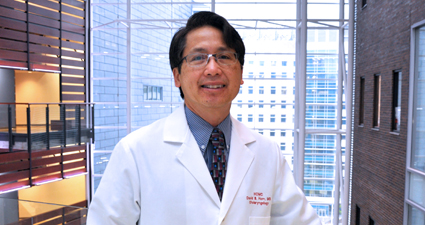
David Hom, MD, Director of Facial Plastic & Reconstructive Surgery, on the UC Academic Health Center campus. Photo by Cindy Starr / Mayfield Clinic.
By David Hom, MD
The topic of facial trauma has been in the news recently as members of the media have told the story of Chris Byrd, whose nose was bitten off during an altercation after a night out with friends. The story had a favorable ending, however, because our surgical team was able to reconstruct the young man’s nose and give him a chance to move on to a more normal life.
Without doubt, Mr. Byrd’s story is one of the more dramatic examples of facial trauma, which we treat at the University of Cincinnati Neuroscience Institute and UC Health. But Mr. Byrd, who was injured in July 2012, also illustrates the rise in facial trauma injuries that my colleagues and I see during a period known as “trauma season,” which begins in April and extends into October.
Facial injuries double during this time, and in a typical week I may see 6, 8 or even 10 cases of traumatic facial injury. The most common of these injuries are broken noses, jaws and cheekbones, accompanied by multiple facial lacerations. If cuts are deep, they can injure the facial nerve, causing the inability to close your eyes, lift up your eyebrows, wrinkle your nose, smile and frown. Such injuries can involve physical pain and disfigurement as well as mental anguish for the patient and family.
Some facial injuries, caused by flying elbows on the basketball court or misjudged fly balls on the baseball field, are true accidents. But facial injuries caused by vehicular accidents and altercations are often the result of unawareness, arrogance or carelessness, and all of us can reduce our chances of suffering a potentially life-changing facial injury by taking a few common sense precautions.
Where altercations are concerned, physicians can almost predict the setting: the individual is leaving a premises at night and is in a parking lot. In the scenarios we see most often, these altercations are random acts that occur when the perpetrator or victim has been drinking or when the victim is talking on a cell phone, texting or walking alone. Distracted by the phone, the victim becomes oblivious to his or her surroundings and fails to intuitively recognize the warning signs that something bad is about to happen. Drinking, texting, talking, walking alone: these all add up to vulnerability.
Meanwhile, many facial injuries that are caused by motor vehicle accidents also have a common thread: a left-hand turn. Picture yourself making a left-hand turn at an intersection: cars are coming toward you, and you can see cars waiting impatiently behind you in your rear-view mirror. People want you to hurry, and you want to comply. The traffic breaks, you start to turn and there – suddenly — is a pedestrian walking across the street. Because left-hand turns carry more risk than may be apparent, drivers should always exercise caution when turning left, and pedestrians should remain vigilant, even if they are crossing in accordance with the traffic signal. I’ve seen it both ways recently: a patient (pedestrian) who had been hit by a commercial truck, and a patient (driver) who made a left-hand turn in front of an oncoming car.
Speed is another factor in facial trauma. As speed limits increase, the severity of facial injuries goes up. Facial surgeons praise the shoulder harness and airbags, which have kept thousands of faces from crashing against dashboards and windshields. But high impacts can still result in facial injury – especially when drivers and passengers are unbelted.
If a facial injury does occur, specialists in trauma surgery, neurosurgery, plastic surgery, oral maxillofacial surgery, ophthalmology and otolaryngology at the UC Medical Center and UC Health work in a comprehensive manner, because an injury to the face can also cause trauma to the brain, eye and neck. Rehabilitation can be lengthy, both physically and psychologically, and these injuries may also require the services of occupational and physical therapists.
Clearly, an ounce of prevention is worth the months of cure that facial trauma requires. As you and your loved ones enjoy the warm weather and the outdoor pleasures that go with it, use your “street smarts.” Be aware of your surroundings, especially at night. Don’t use your phone as you’re walking to your car at night. Obey speed limits, avoid difficult left turns when possible and, if you must turn left, focus on what’s in front of you and not on the impatient driver behind you.
* * *
David Hom, MD, is Professor and Director of Facial Plastic & Reconstructive Surgery in the Department of Otolaryngology-Head & Neck Surgery, at the University of Cincinnati and a facial plastic and reconstructive surgeon at the UC Neuroscience Institute and UC Health.


